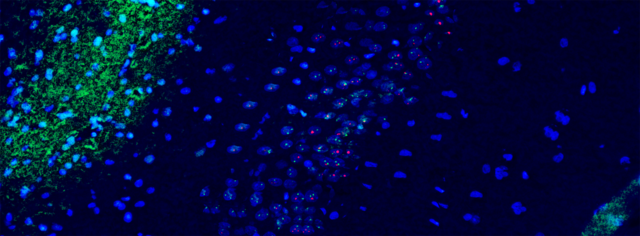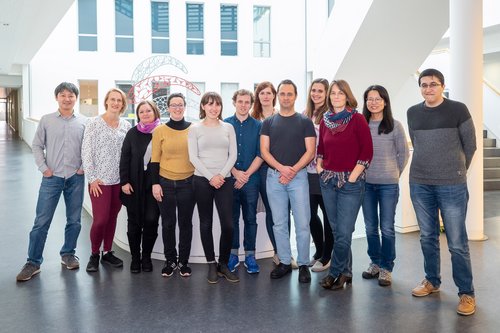Abteilung Funktionelle Architektur des Gedächtnisses
Der Schläfenlappen, auch Temporallappen genannt, ist eine wichtige Hirnstruktur für das Gedächtnis. Kommt es zu Schädigungen dieser Hirnregionen, treten schwerwiegende Gedächtnisstörungen auf – häufig bei älteren Menschen und bei Patienten mit Gedächtnisverlust.
Der Fokus unserer Forschung liegt auf der Identifizierung des spezifischen Beitrags der verschiedenen Areale des medialen Temporallappens zur Gedächtnisleistung unter anderem hinsichtlich Zeit und Raum. Darüberhinaus stehen der Gedächtnisprozess in Bezug auf Vertrautheit/Erinnerung und Speichern/Abruf im Vordergrund unseres Forschungsinteresses sowie das Charakterisieren von Änderungen der Hirnareale im Alterungsprozess.
Ausgewählte Publikationen
- Ku S-P, Atucha E, Alavi N, Mulla-Osman H, Kayumova R, Yoshida M, Csicsvari J, Sauvage MM. 2024. Phase locking of hippocampal CA3 neurons to distal CA1 theta oscillations selectively predicts memory performance. Cell Reports. 43(6):Article 114276.
- Atucha E, Ku SP, Lippert MT, Sauvage MM. 2023. Recalling gist memory depends on CA1 hippocampal neurons for lifetime retention and CA3 neurons for memory precision. Cell Reports. 42(11):113317.
- Beer Z, Vavra P, Atucha E, Rentzing K, Heinze HJ, Sauvage MM. 2018. The memory for time and space differentially engages the proximal and distal parts of the hippocampal subfields CA1 and CA3. PLoS Biology. 16(8):e2006100.
- Lux V, Atucha Trevino E, Kitsukawa T, Sauvage MM. 2016. Imaging a memory trace over half a life-time in the medial temporal lobe reveals a time-limited role of CA3 neurons in retrieval. eLife. e11862.
- Nakamura NH, Flasbeck V, Maingret N, Kitsukawa T, & Sauvage MM. 2013. Proximodistal segregation of nonspatial information in CA3: Preferential recruitment of a proximal CA3-distal CA1 network in nonspatial recognition memory. Journal of Neuroscience, 33(28), 11506-11514.
- Sauvage MM, Fortin N, Owens C, Yonelinas AP, Eichenbaum H. 2008. Recognition memory: opposite effects of hippocampal damage on recollection and familiarity. Nature Neuroscience, 11(1): 16-18.
- Leiterin
Leiterin

Nach ihrer Promotion zu den Auswirkungen von chronischem Stress auf die Gedächtnisfunktion am MPI in München (Holsboer/Steckler lab) folgten für Magdalena Sauvage Postdoc-Anstellungen am MIT (Graybiel lab) und der Universität Boston (Eichenbaum lab). Anschließend übernahm sie Positionen als Senior Research Assistant und Research Assistant Professor im Labor von Prof. Dr. Howard Eichenbaum in Boston, USA. Von 2010 bis 2016 war Prof. Dr. Sauvage als Professorin (W2) an der Ruhr- Universität Bochum tätig.
Seit 2016 leitet sie die Abteilung Funktionelle Architektur des Gedächtnisses und ist Co-Direktorin am LIN.
Das Besondere unserer Forschung ist ein neuartiger experimenteller Ansatz zur Erforschung von Gedächtnisleistungen, bei dem eine Reihe von verschiedenen Techniken kombiniert werden. So kombinieren wir Verhaltenstests mit anderen Methoden z.B. Läsionen, hochauflösender neuroanatomischer Bildgebung und optogenetischen Techniken, als auch mit Mutagenese und in-vivo-Elektrophysiologie.
- Mitglieder
Mitglieder
Leiterin Prof. Dr. Magdalena Sauvage +49-391-6263-94011 magdalena.sauvage@lin-magdeburg.de Sekretariat Jessica Levin +49-391-6263-94531 jessica.levin@lin-magdeburg.de Gruppenleiter Dr. Motoharu Yoshida +49-391-6263-94011 motoharu.yoshida@lin-magdeburg.de Wissenschaftliche Mitarbeiter Dr. Liv Mahnke +49-391-6263-94501 liv.mahnke@lin-magdeburg.de Dr. Erika Atucha Trevino +49-391-6263-94491 erika.trevino@lin-magdeburg.de Doktoranden Yacine Brahimi Halla Mulla-Osman +49-391-6263-94501 Halla.Mulla-Osman@lin-magdeburg.de Rolando Andres Torrado Arevalo Rolando.Torrado@lin-magdeburg.de Technische Mitarbeiter und Laborservice Diana Koch +49-391-6263-94521 diana.koch@lin-magdeburg.de Jeannette Maiwald +49-391-6263-94521 jeanette.maiwald@lin-magdeburg.de Dr. Antonio Reboreda Prieto +49-391-6263-94501 antonio.prieto@lin-magdeburg.de Alumni Rukhshona Kayumova - Projekte
Projekte
Vor Kurzem haben wir das erste kognitive Paradigma für wache Nagetiere entwickelt, welches während funktioneller Magnetresonanztomografie (fMRI) durchgeführt werden kann. Im September 2018 haben wir in Zusammenarbeit mit Eike Budinger einen 9,4-Tesla-Kleintierscanner samt Labor am LIN eingeweiht.
Auch eine Verhaltensstudie mit Menschen haben wir durchgeführt, um Gedächtnisdefizite zum Beispiel bei Patienten mit posttraumatischen Störungen besser charakterisieren zu können. In Zusammenarbeit mit Emrah Düzel vom DZNE Magdeburg sind wir an Experimenten im 7-Tesla-Kernspintomografen beteiligt.
Innerhalb des Sonderforschungsbereiches 874 beschäftigten wir uns mit den neuronalen Grundlagen von Vertrautheit und wir charakterisieren im Rahmen des Sonderforschungsbereichs 779 neu identifizierte Netzwerke im Hippocampus, die dem räumlichen und nicht-räumlichen Erinnern zugeschrieben werden.
Unsere Forschungsschwerpunkte im Überblick:
- Charakterisierung der spezifischen Rolle der MTL-Areale im räumlichen und nicht-räumlichen Gedächtnis in Abhängigkeit von visuellen oder olfaktorischen Sinnesmodalitäten (Verhaltenstest, Gehirnläsionen und neuroanatomische Bildgebung des Gehirns)
- Bewertung von Gedächtnisleistung und Untersuchung der Reorganisation der MTL- Bereiche nach Hirnverletzungen an Amnesiemodellen (Verhaltenstests, Gehirnläsionen und neuroanatomische Bildgebung des Gehirns)
- Charakterisierung von Gedächtnisleistung und Gehirnveränderungen in alternden Modellen (Verhaltenstests und neuroanatomische Bildgebung des Gehirns)
- Entwicklung von übertragbaren Verhaltenstests und übertragbaren kognitiven Verhaltenstest im fMRT an wachen Nagetieren (Verhaltenstest, stereotaktische Chirurgie, fMRT an Tieren)
- Techniken
Techniken
Wir nutzen Gedächtnistests, die bei Mensch und Tier gleichermaßen eingesetzt werden können – beispielsweise übertragen wir Erinnerungstest für Menschen auf Nagetiere.
Das Besondere unserer Forschung ist ein neuartiger experimenteller Ansatz zur Erforschung von Gedächtnisleistungen, beim dem eine Reihe von verschiedenen Techniken kombiniert werden. So werden Verhaltenstests mit anderen Methoden z.B. Läsionen, hochauflösender neuroanatomischer Bildgebung und optogenetischen Techniken, als auch mit Mutagenese und in-vivo-Elektrophysiologie verknüpft.
Zudem arbeiten wir derzeit an der Entwicklung kognitiver fMRT-Paradigmen für fMRT-Messungen an wachen Nagetieren, mit dem Ziel menschliche und tierische Gedächtnisprozesse vergleichbarer zu machen.
Um Gedächtnisdefizite bei Patienten mit Depressionen oder Posttraumatischem Stresssyndrom genauer charakterisieren zu können, führen wir ebenso Verhaltenstests an Menschen durch.
Anwendungsbeispiele unserer Techniken sind unter anderem:
- Charakterisierung der spezifischen Rolle der MTL-Areale im räumlichen und nicht-räumlichen Gedächtnis in Abhängigkeit von visuellen oder olfaktorischen Sinnesmodalitäten (Verhaltenstest, Gehirnläsionen und neuroanatomische Bildgebung des Gehirns)
- Bewertung von Gedächtnisleistung und Untersuchung der Reorganisation der MTL- Bereiche nach Hirnverletzungen an Amnesiemodellen (Verhaltenstests, Gehirnläsionen und neuroanatomische Bildgebung des Gehirns)
- Charakterisierung von Gedächtnisleistung und Gehirnveränderungen in alternden Modellen (Verhaltenstests und neuroanatomische Bildgebung des Gehirns)
- Entwicklung von übertragbaren Verhaltenstests und übertragbaren kognitiven Verhaltenstest im fMRT an wachen Nagetieren (Verhaltenstest, Chirurgie, fMRT an Tieren)

Techniken im Überblick: Gen-(IEG)-basierte molekulare Bildgebung, Optogenetik, Verhaltensversuche und funktionelle Bildgebung (fMRT) in wachen Ratten - Laufende Drittmittelprojekte
Laufende Drittmittelprojekte
2022- 2025
DFG grant
"Zelluläre Mechanismen des Kurzzeitgedächtnisses in der hippocampalen CA1 Region"
2021-2024
DFG SFB 1436 B01
"Medial temporal lobe and prefrontal cortex connectivity as a neural resource for recognition memory"
http://www.iknd.ovgu.de/SFB+1436.html
2021-2024
DFG grant
„Contribution of the hippocampal subfield CA1, CA3 and the trisynaptic and temporoamonic pathways to the retrieval of memory over half a life time”
- Publikationen
Publikationen
Ausgewählte Publikationen
Ku S-P, Atucha E, Alavi N, Mulla-Osman H, Kayumova R, Yoshida M, Csicsvari J, Sauvage MM. 2024. Phase locking of hippocampal CA3 neurons to distal CA1 theta oscillations selectively predicts memory performance. Cell Reports. 43(6):Article 114276. https://doi.org/10.1016/j.celrep.2024.114276
Saber Marouf B, Reboreda A, Theissen F, Kaushik R, Sauvage M, Dityatev A, Yoshida M. 2023. TRPC4 Channel Knockdown in the Hippocampal CA1 Region Impairs Modulation of Beta Oscillations in Novel Context. Biology. 12(4):Article 629.https://doi.org/10.3390/biology12040629
Schott BH, Soch J, Kizilirmak JM, Schütze H, Assmann A, Maass A, Ziegler G, Sauvage M, Richter A. 2023. Inhibitory temporo-parietal effective connectivity is associated with explicit memory performance in older adults. iScience. 26(10):Article 107765.https://doi.org/10.1016/j.isci.2023.107765
Beer Z, Vavra P, Atucha E, Rentzing K, Heinze HJ, Sauvage MM. 2018. The memory for time and space differentially engages the proximal and distal parts of the hippocampal subfields CA1 and CA3. PLoS Biology. 16(8):e2006100. https://doi.org/10.1371/journal.pbio.2006100Behroozi M, Chwiesko C, Ströckens F, Sauvage M, Helluy X, Peterburs J, Güntürkün O. 2018. In vivo measurement of T1 and T2 relaxation times in awake pigeon and rat brains at 7T. Magnetic Resonance in Medicine. 79(2):1090-1100. https://doi.org/10.1002/mrm.26722
Lux V, Masseck OA, Herlitze S, Sauvage MM. 2017. Optogenetic Destabilization of the Memory Trace in CA1: Insights into Reconsolidation and Retrieval Processes. Cerebral Cortex. 27(1):841-851. https://doi.org/10.1093/cercor/bhv282
Lux V, Atucha E, Kitsukawa T, Sauvage MM. 2016. Imaging a memory trace over half a life-time in the medial temporal lobe reveals a time-limited role of CA3 neurons in retrieval. eLife. 5(FEBRUARY2016):Article e11862. https://doi.org/10.7554/eLife.11862
Nakamura NH, Sauvage MM. 2016. Encoding and reactivation patterns predictive of successful memory performance are topographically organized along the longitudinal axis of the hippocampus. Hippocampus. 26(1):67-75. https://doi.org/10.1002/hipo.22491
Sauvage MM, Beer Z, Ekovich M, Ho L, Eichenbaum H. 2010. The caudal medial entorhinal cortex: A selective role in recollection-based recognition memory. Journal of Neuroscience. 30(46):15695-15699. https://doi.org/10.1523/JNEUROSCI.4301-10.2010
Sauvage M, Fortin N, Owens C, Yonelinas AP, Eichenbaum H. 2008. Recognition memory: opposite effects of hippocampal damage on recollection and familiarity. Nature Neuroscience. 11(1): 16-8.
Alle Publikationen der Abteilung
2025
Atucha E, Pais M, Ronzoni G, Schoenmaker C, Atsak P, Roura D, Lohkamp KL, Schelling G, McGaugh JL, Glennon JC, Aschrafi A, Roozendaal B. 2025. Noradrenergic activation of the basolateral amygdala facilitates memory specificity for similar events experienced close in time. Nature Neuroscience. 28(9):1910–1918. https://doi.org/10.1038/s41593-025-02014-0
2024
Ku S-P, Atucha E, Alavi N, Mulla-Osman H, Kayumova R, Yoshida M, Csicsvari J, Sauvage MM. 2024. Phase locking of hippocampal CA3 neurons to distal CA1 theta oscillations selectively predicts memory performance. Cell Reports. 43(6):Article 114276. https://doi.org/10.1016/j.celrep.2024.114276
2023Atucha E, Ku S-P, Lippert MT, Sauvage MM. 2023, Recalling gist memory depends on CA1 hippocampal neurons for lifetime retention and CA3 neurons for memory precision. Cell Reports. 42(11): 113317. https://doi.org/10.1016/j.celrep.2023.113317
Ying J, Reboreda A, YoshidaM, Brandon MP. 2023, Grid cell disruption in a mouse model of early Alzheimer's disease reflects reduced integration of self-motion cues. Current Biology. 33(12): 2425-2437.e5. https://doi.org/10.1016/j.cub.2023.04.065
Brahimi Y, Knauer B, Price AT, Valero Aracama MJ, Reboreda A, Sauvage M, Yoshida M. 2023. Persistent Firing in Hippocampal CA1 Pyramidal Cells in Young and Aged Rats. eNeuro. https://doi.org/10.1523/ENEURO.0479-22.2023
2022
Grande X, Sauvage MM, Becke A, Düzel E, Berron D. 2022. Transversal functional connectivity and scene-specific processing in the human entorhinal-hippocampal circuitry. eLife. 11:Article e76479. https://doi.org/10.7554/eLife.76479
2021
Arboit A, Ku S-P, Krautwald K, Angenstein F. 2021. Brief neuronal afterdischarges in the rat hippocampus lead to transient changes in oscillatory activity and to a very long-lasting decline in BOLD signals without inducing a hypoxic state. NeuroImage. 245:Article 118769. https://doi.org/10.1016/j.neuroimage.2021.118769
Atucha E, Ku S-P, Lippert M, Sauvage M. 2021. Remembering the gist of an event over a lifetime depends on the hippocampus. bioRxiv. https://doi.org/10.1101/2021.04.14.439803
Crittenden JR, Zhai S, Sauvage M, Kitsukawa T, Burguière E, Thomsen M, Zhang H, Costa C, Martella G, Ghiglieri V, et al. 2021. CalDAG-GEFI mediates striatal cholinergic modulation of dendritic excitability, synaptic plasticity and psychomotor behaviors. Neurobiology of Disease. 158:Article 105473. https://doi.org/10.1016/j.nbd.2021.105473
Grande X, Sauvage M, Becke A, Düzel E, Berron D. 2021. Functional connectivity and information pathways in the human entorhinal-hippocampal circuitry. (bioRxiv). https://doi.org/10.1101/2021.12.17.473123
Henschke JU, Price AT, Pakan JMP. 2021. Enhanced modulation of cell-type specific neuronal responses in mouse dorsal auditory field during locomotion. Cell calcium. 96:Article 102390. https://doi.org/10.1016/j.ceca.2021.102390
Ku S-P, Hargreaves EL, Wirth S, Suzuki WA. 2021. The contributions of entorhinal cortex and hippocampus to error driven learning. Communications biology. 4(1):Article 618. https://doi.org/10.1038/s42003-021-02096-z
Mahnke L, Atucha E, Pina-Fernàndez E, Kitsukawa T, Sauvage MM. 2021. Lesion of the hippocampus selectively enhances LEC's activity during recognition memory based on familiarity. Scientific Reports. 11(1):Article 19085. https://doi.org/10.1038/s41598-021-98509-4
Oulé M, Atucha E, Wells TM, Macharadze T, Sauvage MM, Kreutz MR, Lopez-Rojas J. 2021. Dendritic Kv4.2 potassium channels selectively mediate spatial pattern separation in the dentate gyrus. iScience. 24(8):102876. https://doi.org/10.1016/j.isci.2021.102876
Valero-Aracama MJ, Reboreda A, Arboit A, Sauvage M, Yoshida M. 2021. Noradrenergic suppression of persistent firing in hippocampal CA1 pyramidal cells through cAMP-PKA pathway. eNeuro. 8(2):1-12. https://doi.org/10.1523/ENEURO.0440-20.2020
2020
Arboit A, Reboreda A, Yoshida M. 2020. Involvement of TRPC4 and 5 Channels in Persistent Firing in Hippocampal CA1 Pyramidal Cells. Cells. 9(2):Article 365. https://doi.org/10.3390/cells9020365
Kessler H, Schmidt AC, James EL, Blackwell SE, von Rauchhaupt M, Harren K, Kehyayan A, Clark IA, Sauvage M, Herpertz S, et al. 2020. Visuospatial computer game play after memory reminder delivered three days after a traumatic film reduces the number of intrusive memories of the experimental trauma. Journal of Behavior Therapy and Experimental Psychiatry. 67:Article 101454. https://doi.org/10.1016/j.jbtep.2019.01.006
Mahnke L, Atucha E, Kitsukawa T, Sauvage MM. 2020. Recognition memory: familiarity signals increase selectively in the lateral entorhinal cortex following hippocampal lesions. bioRxiv. https://doi.org/10.1101/2020.06.16.131763
Rivas-Ramírez P, Reboreda A, Rueda-Ruzafa L, Herrera-Pérez S, Lamas JA. 2020. Contribution of KCNQ and TREK Channels to the Resting Membrane Potential in Sympathetic Neurons at Physiological Temperature. International Journal of Molecular Sciences. 21(16):1-16. https://doi.org/10.3390/ijms21165796
2019
Knauer B, Yoshida M. 2019. Switching between persistent firing and depolarization block in individual rat CA1 pyramidal neurons. Hippocampus. 29(9):817-835. https://doi.org/10.1002/hipo.23078
Krautwald K, Mahnke L, Angenstein F. 2019. Electrical Stimulation of the Lateral Entorhinal Cortex Causes a Frequency-Specific BOLD Response Pattern in the Rat Brain. Frontiers in Neuroscience. 13(MAY):Article 539. https://doi.org/10.3389/fnins.2019.00539
Sauvage M, Kitsukawa T, Atucha E. 2019. Single-cell memory trace imaging with immediate-early genes. Journal of Neuroscience Methods. 326:108368. https://doi.org/10.1016/j.jneumeth.2019.108368
Crittenden J., Sauvage M, Kitsukawa T, Burguière E, Cepeda C, André VM, Canault M, Thomsen M, Zhang H, Costa C, Martella G, Ghiglieri V, Pescatore KA, Unterwald EM, Jackson W, Housman DE, Caine SB, Sulzer D, Calabresi P, Levine MS, Brefel-Courbon C, Smith AC, Alessi MC, Azulay JP, Graybiel AM. 2019. Mutations in CalDAG-GEFI Lead to Striatal Signaling Deficits and Psychomotor Symptoms in Multiple Species Including Human. https://www.biorxiv.org/content/10.1101/709246v1
2018
Beer Z, Vavra P, Atucha E, Rentzing K, Heinze HJ, Sauvage MM. 2018. The memory for time and space differentially engages the proximal and distal parts of the hippocampal subfields CA1 and CA3. PLoS Biology. 16(8):e2006100. https://doi.org/10.1371/journal.pbio.2006100
Behroozi M, Chwiesko C, Ströckens F, Sauvage M, Helluy X, Peterburs J, Güntürkün O. 2018. In vivo measurement of T1 and T2 relaxation times in awake pigeon and rat brains at 7T. Magnetic Resonance in Medicine. 79(2):1090-1100. https://doi.org/10.1002/mrm.26722
Berron D, Neumann K, Maass A, Schütze H, Fliessbach K, Kiven V, Jessen F, Sauvage M, Kumaran D, Düzel E. 2018. Age-related functional changes in domain-specific medial temporal lobe pathways. Neurobiology of Aging. 65:86-97. https://doi.org/10.1016/j.neurobiolaging.2017.12.030
Fernández-Fernández D, Cadaveira-Mosquera A, Rueda-Ruzafa L, Herrera-Pérez S, Veale EL, Reboreda A, Mathie A, Antonio Lamas J. 2018. Activation of TREK currents by riluzole in three subgroups of cultured mouse nodose ganglion neurons. PLoS ONE. 13(6). https://doi.org/10.1371/journal.pone.0199282
Flasbeck V, Atucha E, Nakamura NH, Yoshida M, Sauvage MM. 2018. Spatial information is preferentially processed by the distal part of CA3: implication for memory retrieval. Behavioural Brain Research. 354:31-38. https://doi.org/10.1016/j.bbr.2018.07.023
Reboreda A, Theissen FM, Valero-Aracama MJ, Arboit A, Corbu MA, Yoshida M. 2018. Do TRPC channels support working memory? Comparing modulations of TRPC channels and working memory through G-protein coupled receptors and neuromodulators. Behavioural Brain Research. 354:64 - 83. https://doi.org/10.1016/j.bbr.2018.02.042
2017
Atucha E, Karew A, Kitsukawa T, Sauvage MM. 2017. Recognition memory: Cellular evidence of a massive contribution of the LEC to familiarity and a lack of involvement of the hippocampal subfields CA1 and CA3. Hippocampus. 27(10):1083-1092. https://doi.org/10.1002/hipo.22754
Atucha E, Vukojevic V, Fornari RV, Ronzoni G, Demougin P, Peter F, Atsak P, Coolen MW, Papassotiropoulos A, McGaugh JL, de Quervain DJF, Roozendaal B. 2017. Noradrenergic activation of the basolateral amygdala maintains hippocampus-dependent accuracy of remote memory. Proceedings of the National Academy of Sciences of the United States of America. 114(34):9176-9181. https://doi.org/10.1073/pnas.1710819114
Cutsuridis V, Yoshida M. 2017. Editorial: Memory processes in medial temporal lobe: Experimental, theoretical and computational approaches. Frontiers in Systems Neuroscience. 11:Article 19. https://doi.org/10.3389/fnsys.2017.00019
Giovannini F, Knauer B, Yoshida M, Buhry L. 2017. The CAN-In network: A biologically inspired model for self-sustained theta oscillations and memory maintenance in the hippocampus. Hippocampus. 27(4):450-463. https://doi.org/10.1002/hipo.22704
Ku SP, Nakamura NH, Maingret N, Mahnke L, Yoshida M, Sauvage MM. 2017. Regional specific evidence for memory-load dependent activity in the dorsal subiculum and the lateral entorhinal cortex. Frontiers in Systems Neuroscience. 11:Article 51. https://doi.org/10.3389/fnsys.2017.00051
Lux V, Masseck OA, Herlitze S, Sauvage MM. 2017. Optogenetic Destabilization of the Memory Trace in CA1: Insights into Reconsolidation and Retrieval Processes. Cerebral Cortex. 27(1):841-851. https://doi.org/10.1093/cercor/bhv282
2016
Hamburg H, Trossbach SV, Bader V, Chwiesko C, Kipar A, Sauvage M, Crum WR, Vernon AC, Bidmon HJ, Korth C. 2016. Simultaneous effects on parvalbumin-positive interneuron and dopaminergic system development in a transgenic rat model for sporadic schizophrenia. Scientific Reports. 6:Article 34946. https://doi.org/10.1038/srep34946
Lux V, Atucha Trevino E, Kitsukawa T, Sauvage MM. 2016. Imaging a memory trace over half a life-time in the medial temporal lobe reveals a time-limited role of CA3 neurons in retrieval. eLife. 5(FEBRUARY2016):Article e11862. https://doi.org/10.7554/eLife.11862
Nakamura NH, Sauvage MM. 2016. Encoding and reactivation patterns predictive of successful memory performance are topographically organized along the longitudinal axis of the hippocampus. Hippocampus. 26(1):67-75. https://doi.org/10.1002/hipo.22491
Trossbach SV, Bader V, Hecher L, Pum ME, Masoud ST, Prikulis I, Schäble S, de Souza Silva MA, Su P, Boulat B, Chwiesko C, Poschmann G, Stühler K, Lohr KM, Stout KA, Oskamp A, Godsave SF, Müller-Schiffmann A, Bilzer T, Steiner H, Peters PJ, Bauer A, Sauvage M, Ramsey AJ, Miller GW, Liu F, Seeman P, Brandon NJ, Huston JP, Korth C. 2016. Misassembly of full-length Disrupted-in-Schizophrenia 1 protein is linked to altered dopamine homeostasis and behavioral deficits. Molecular Psychiatry. 21(11):1561-1572. https://doi.org/10.1038/mp.2015.194
Yoshida M. 2016. Mechanisms and Roles of Intrinsic Persistent Firing in the Hippocampus. Seibutsu Butsuri. 56(5). https://doi.org/10.2142/biophys.56.262
2015
Jochems A, Yoshida M. 2015. A robust in vivo-like persistent firing supported by a hybrid of intracellular and synaptic mechanisms. PLoS ONE. 10(4):Article e0123799. https://doi.org/10.1371/journal.pone.0123799
Kabanova A, Pabst M, Lorkowski M, Braganza O, Boehlen A, Nikbakht N, Pothmann L, Vaswani AR, Musgrove R, Di Monte DA, Sauvage M, Beck H, Blaess S. 2015. Function and developmental origin of a mesocortical inhibitory circuit. Nature Neuroscience. 18(6):872-882. https://doi.org/10.1038/nn.4020
Saravanan V, Arabali D, Jochems A, Cui AX, Gootjes-Dreesbach L, Cutsuridis V, Yoshida M. 2015. Transition between encoding and consolidation/replay dynamics via cholinergic modulation of CAN current: A modeling study. Hippocampus. 25(9):1052-1070. https://doi.org/10.1002/hipo.22429
Valero-Aracama MJ, Sauvage MM, Yoshida M. 2015. Environmental enrichment modulates intrinsic cellular excitability of hippocampal CA1 pyramidal cells in a housing duration and anatomical location-dependent manner. Behavioural Brain Research. 292:209-218. https://doi.org/10.1016/j.bbr.2015.05.032
2014
Beer Z, Chwiesko C, Sauvage MM. 2014. Processing of spatial and non-spatial information reveals functional homogeneity along the dorso-ventral axis of CA3, but not CA1. Neurobiology of Learning and Memory. 111:56-64. https://doi.org/10.1016/j.nlm.2014.03.001
Herold C, Bingman VP, Ströckens F, Letzner S, Sauvage M, Palomero-Gallagher N, Zilles K, Güntürkün O. 2014. Distribution of neurotransmitter receptors and zinc in the pigeon (Columba livia) hippocampal formation: A basis for further comparison with the mammalian hippocampus. Journal of Comparative Neurology. 522(11):2553-2575. https://doi.org/10.1002/cne.23549
Wiemers US, Sauvage MM, Wolf OT. 2014. Odors as effective retrieval cues for stressful episodes. Neurobiology of Learning and Memory. 112:230-236. https://doi.org/10.1016/j.nlm.2013.10.004
2013
Beer Z, Chwiesko C, Kitsukawa T, Sauvage MM. 2013. Spatial and stimulus-type tuning in the LEC, MEC, POR, PrC, CA1, and CA3 during spontaneous item recognition memory. Hippocampus. 23(12):1425-1438. https://doi.org/10.1002/hipo.22195
Nakamura NH, Flasbeck V, Maingret N, Kitsukawa T, Sauvage MM. 2013. Proximodistal segregation of nonspatial information in CA3: Preferential recruitment of a proximal CA3-distal CA1 network in nonspatial recognition memory. Journal of Neuroscience. 33(28):11506-11514. https://doi.org/10.1523/JNEUROSCI.4480-12.2013
Sauvage MM, Nakamura NH, Beer Z. 2013. Mapping memory function in the medial temporal lobe with the immediate-early gene Arc. Behavioural Brain Research. 254:22-33. https://doi.org/10.1016/j.bbr.2013.04.048
Wiemers US, Sauvage MM, Schoofs D, Hamacher-Dang TC, Wolf OT. 2013. What we remember from a stressful episode. Psychoneuroendocrinology. 38(10):2268-2277. https://doi.org/10.1016/j.psyneuen.2013.04.015
2012
Eichenbaum H, Sauvage M, Fortin N, Komorowski R, Lipton P. 2012. Towards a functional organization of episodic memory in the medial temporal lobe. Neuroscience and Biobehavioral Reviews. 36(7):1597-1608. https://doi.org/10.1016/j.neubiorev.2011.07.006
Eichenbaum H, Sauvage M, Fortin N, Robitsek J, Komorowski R. 2012. A Comparative Analysis of Episodic Memory: Cognitive Mechanisms and Neural Substrates. In The Oxford Handbook of Comparative Cognition. Oxford University Press. https://doi.org/10.1093/oxfordhb/9780195392661.013.0017
Place R, Lykken C, Beer Z, Suh J, McHugh TJ, Tonegawa S, Eichenbaum H, Sauvage MM. 2012. NMDA signaling in CA1 mediates selectively the spatial component of episodic memory. Learning and Memory. 19(4):164-169. https://doi.org/10.1101/lm.025254.111
Sauvage MM. 2012. Neural substrates of recollection and familiarity: Further bridging human and animal recognition memory using translational paradigms. In Psychology of Memory. Nova Science Publishers, Inc. pp. 155-182.
2010
Eichenbaum H, Fortin N, Sauvage M, Robitsek RJ, Farovik A. 2010. An animal model of amnesia that uses Receiver Operating Characteristics (ROC) analysis to distinguish recollection from familiarity deficits in recognition memory. Neuropsychologia. 48(8):2281-2289. https://doi.org/10.1016/j.neuropsychologia.2009.09.015
Sauvage MM, Beer Z, Eichenbaum H. 2010. Recognition memory: Adding a response deadline eliminates recollection but spares familiarity. Learning and Memory. 17(2):104-108. https://doi.org/10.1101/lm.1647710
Sauvage MM, Beer Z, Ekovich M, Ho L, Eichenbaum H. 2010. The caudal medial entorhinal cortex: A selective role in recollection-based recognition memory. Journal of Neuroscience. 30(46):15695-15699. https://doi.org/10.1523/JNEUROSCI.4301-10.2010
Sauvage MM. 2010. ROC in animals: Uncovering the neural substrates of recollection and familiarity in episodic recognition memory. Consciousness and Cognition. 19(3):816-828. https://doi.org/10.1016/j.concog.2010.06.023
- Konferenz-Reihe "Functional Architecture of Memory"
Konferenz-Reihe "Functional Architecture of Memory"
Die FAM-Konferenzen zielen darauf ab, neue Erkenntnisse zu wichtigen Kontroversen im Bereich der Gedächtnisforschung hervorzubringen sowie Parallelen des menschlichen und tierischen Gedächtnisses aufzuzeigen. Die Veranstaltung wird alle 2 Jahre von unserer Abteilung organisiert.
Zwanzig der weltweit führenden Experten zur Forschung am medialen Temporallappen und für Gedächtnisfunktion diskutieren ihre Ergebnisse, die aus Verhaltensstudien, Techniken der Bildgebung und Elektrophysiologie stammen sowie Resultate von Mutagenese und Computertechniken sind.
Die nächste FAM-Konferenz findet vermutlich im Mai 2024 statt.
Sprecher der FAM-Konferenz 2022

- Kooperationspartner
Kooperationspartner
International/National
- Dr. Susumu Tonegawa (MIT/RIKEN, USA)
- Dr. Jozsef Csicsvari (IST, Austria),
- Dr. Takashi Kitsukawa (Osaka University, Japan)
- Prof. Dr. Kitamura (Northwestern U, USA)
- Prof. Dr. Mathias Hoehn (MPI for Neurological Research, Cologne)
- Prof. Dr. Stephan Herpertz (Medical Faculty, LWL, Clinic for Psychosomatic Medicine and Psychotherapy, Bochum)
- Dr. Andrew Yonelinas (UCDavis, USA)
- Prof. Dr. Dr. Onur Güntürkün and Prof. Dr. Boris Suchan (Faculty of Psychology, RUB, Germany)
- Prof. Dr. Michael Yassa (Irvine, USA)
- Dr. Sheena Josselyn (Sickkids, Toronto, Canada)
Lokal:
- Prof. Dr. Emrah Düzel (DZNE)
- Prof. Dr. Frank Angenstein (DZNE)
- Dr. Eike Budinger (LIN)
- Dr. Motoharu Yoshida (LIN/DZNE)
- Medienberichterstattung
Medienberichterstattung
Wie sich Gedächtnisverlust aufhalten lässt, DerStandard
"Weiß ich nicht mehr", Brigitte 02/2023
Worum geht’s ... in der Gedächtnisforschung?, Die Zeit (01/2022)
Wie erinnern wir uns an unseren ersten Schultag?, MDR Wissen
How Does The Brain Manage Everyday Memory Events?, Science Trend
Gedächtnisforschung in Magdeburg, MDR aktuell
- Hirnforschung spielerisch erklärt, General-Anzeiger Magdeburg



